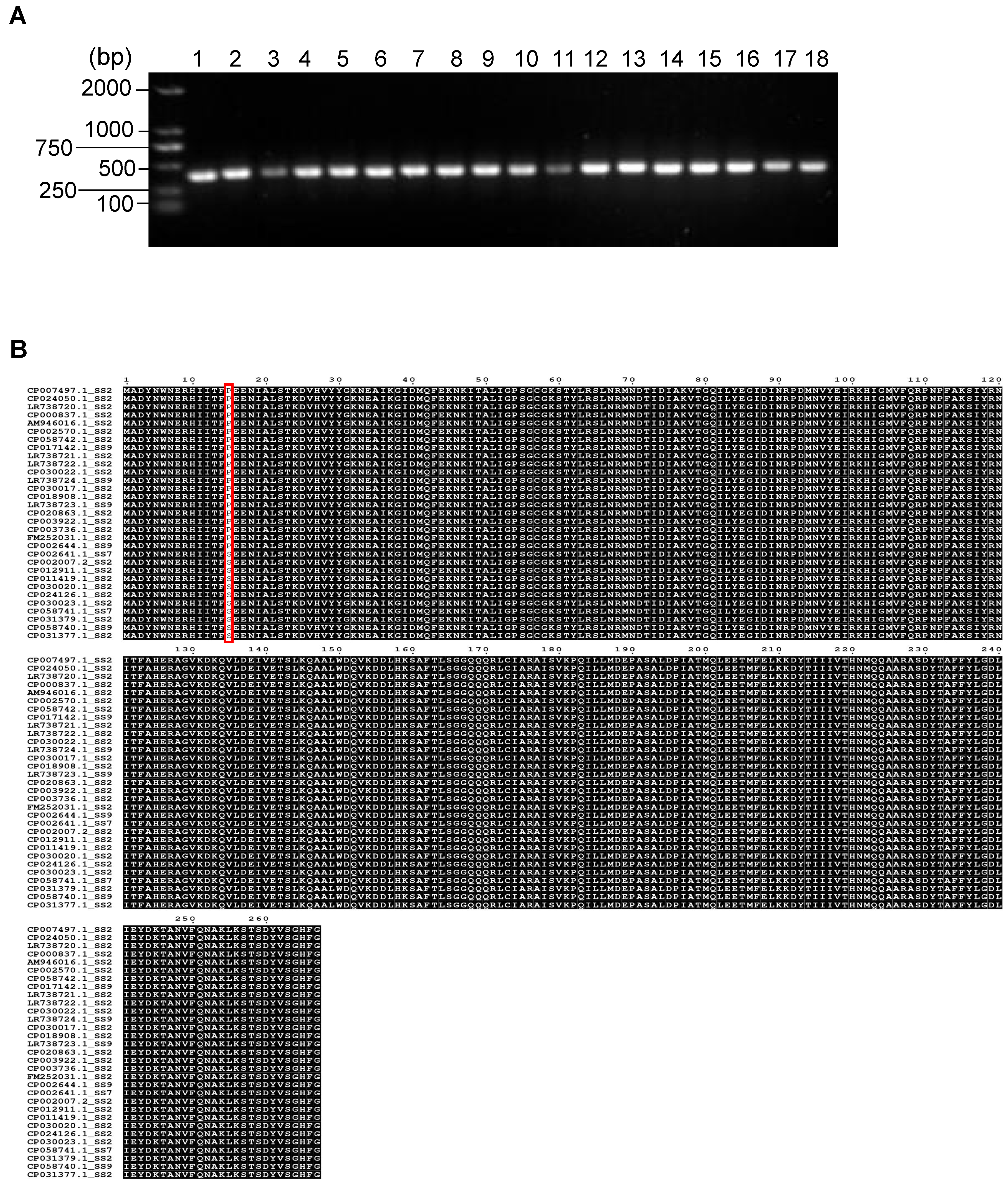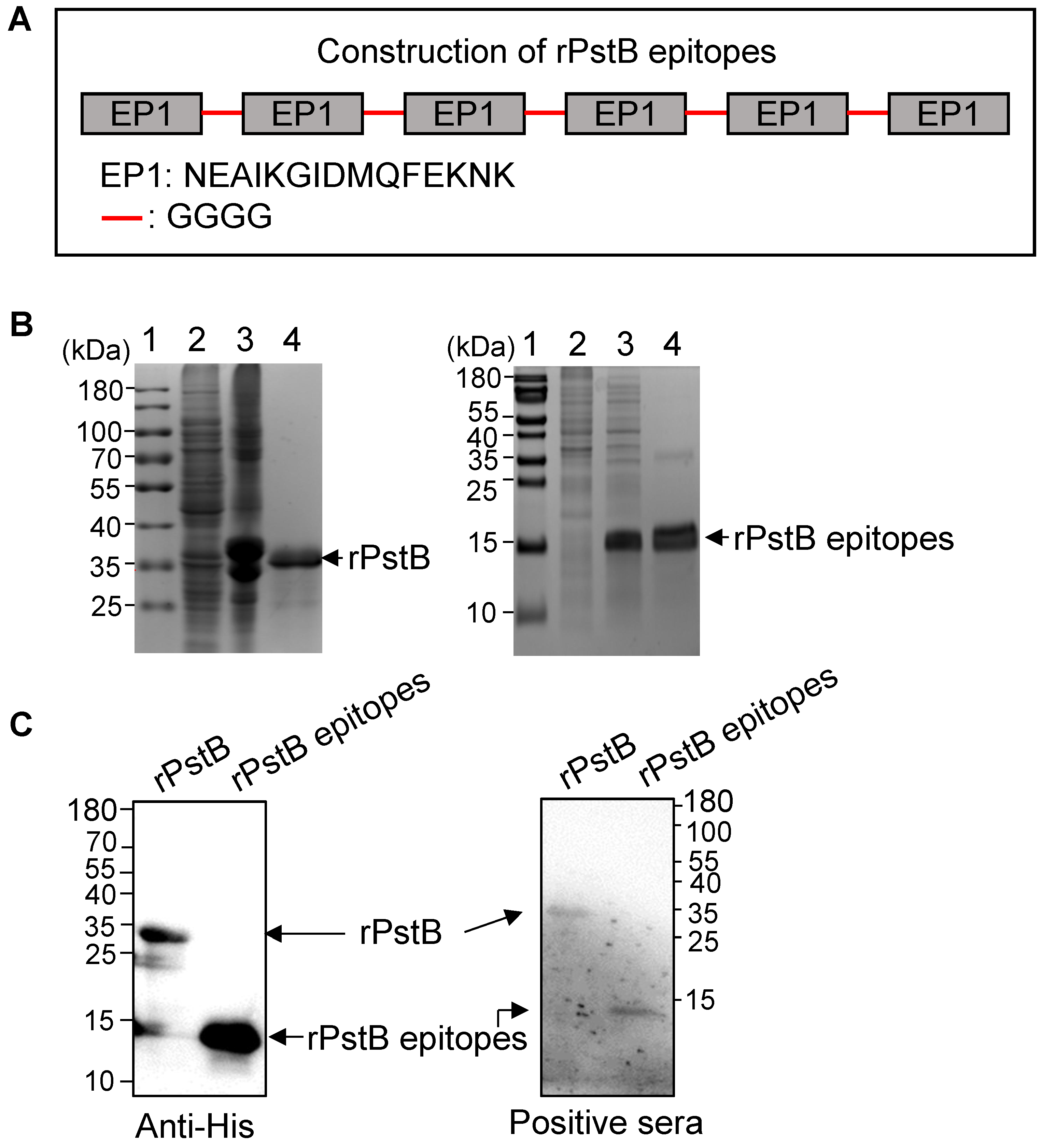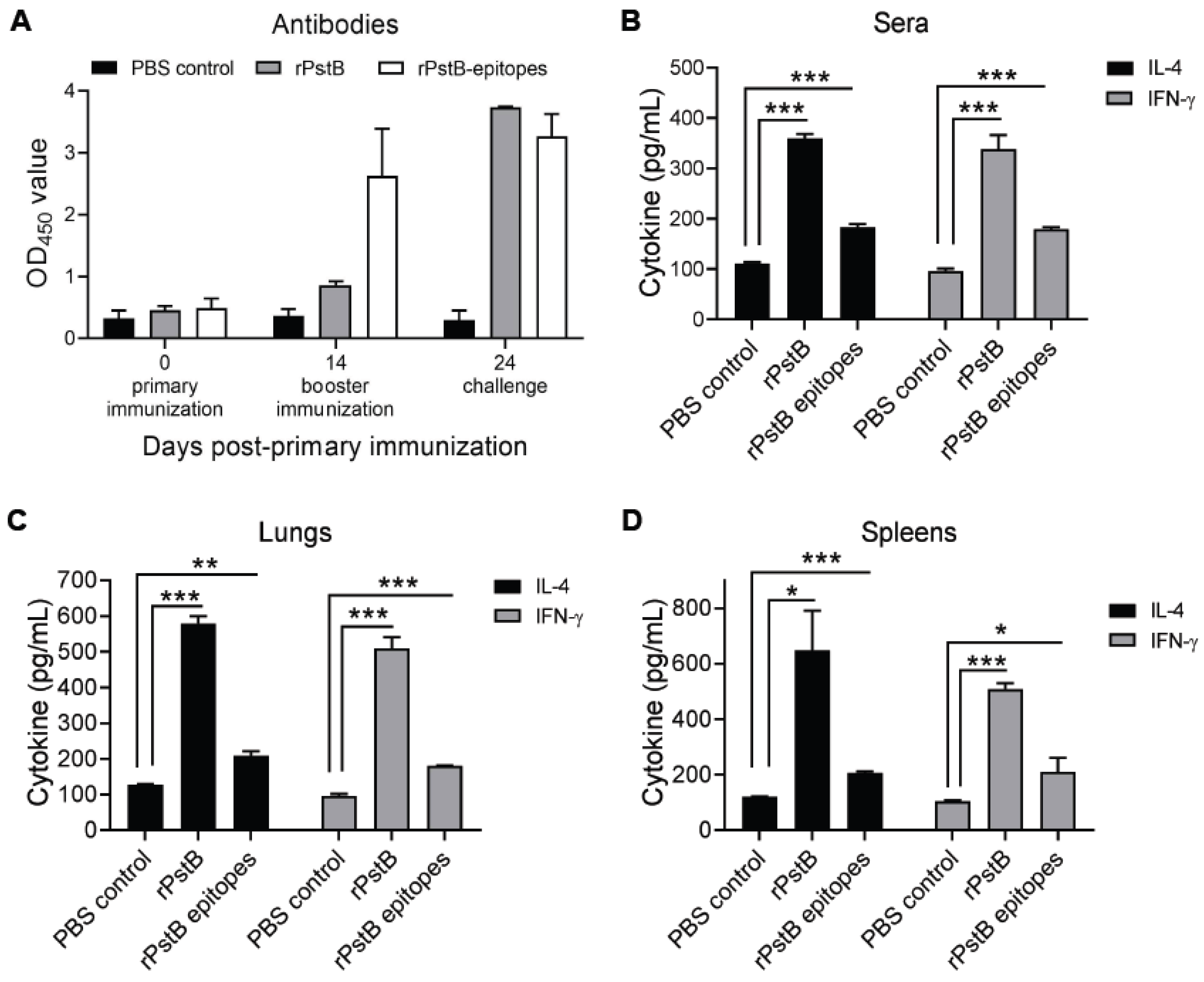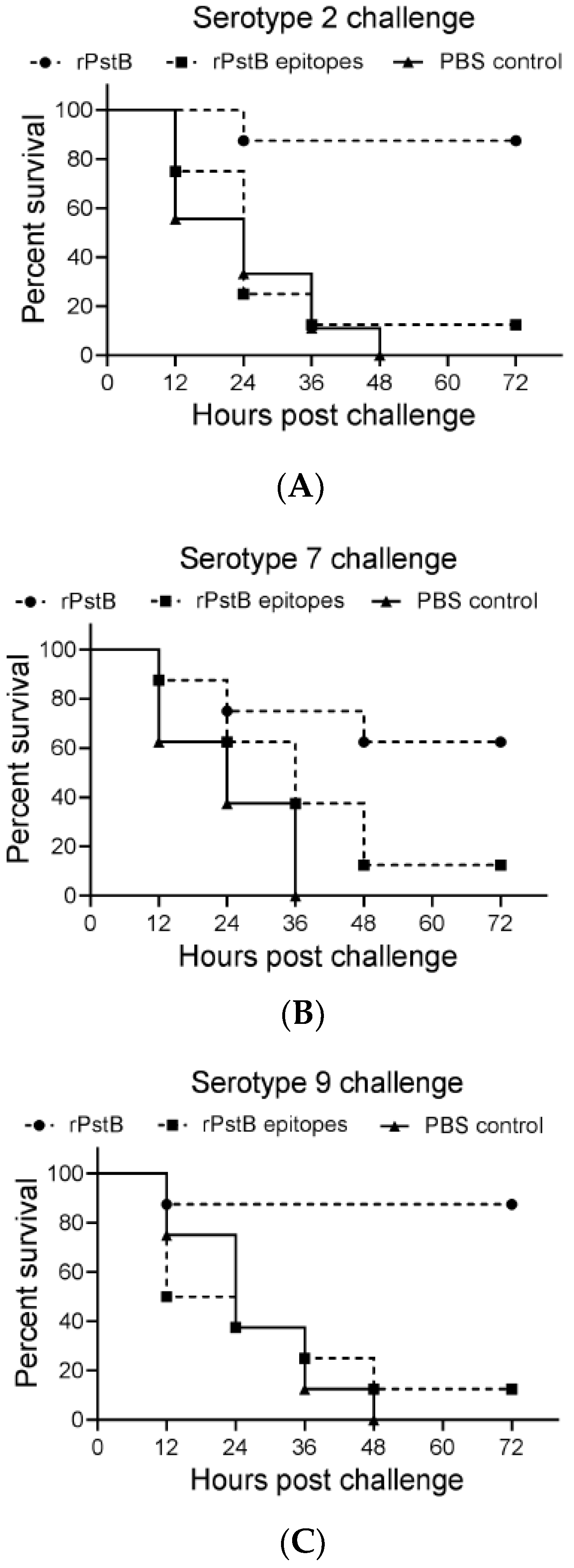Subunit Vaccine Targeting Phosphate ABC Transporter ATP-Binding Protein, PstB, Provides Cross-Protection against Streptococcus suis Serotype 2, 7, and 9 in Mice
Abstract
Simple Summary
Abstract
1. Introduction
2. Materials and Methods
2.1. Analysis of Sequence Conservation of PstB
2.2. Prediction of Linar B Cell Epitopes and Enzyme Linked Immunosorbent Assay (ELISA) Analysis
2.3. Expression and Purification of Recombinant Proteins
2.4. Western Blot Analysis
2.5. Immunization and Challenge
2.6. ELISA for Detection of Antibody
2.7. Detection of IFN-γ and IL-4
2.8. Statistical Analysis
3. Results
3.1. Prevalence and Conservation of PstB among S. suis Strains
3.2. Linear Immunodominant B Cell Epitopes of PstB Screened by ELISA
3.3. Expression and Purification of rPstB and rPstB-Epitope
3.4. Antibodies and Cytokines in Immunized Mice
3.5. Protection of rPstB and rPstB-Epitope against S. suis Infection in Mice
4. Discussion
5. Conclusions
Supplementary Materials
Author Contributions
Funding
Institutional Review Board Statement
Informed Consent Statement
Data Availability Statement
Conflicts of Interest
References
- Staats, J.J.; Feder, I.; Okwumabua, O.; Chengappa, M.M. Streptococcus suis: Past and Present. Vet. Res. Commun. 1997, 21, 381–407. [Google Scholar] [CrossRef] [PubMed]
- Fittipaldi, N.; Segura, M.; Grenier, D.; Gottschalk, M. Virulence Factors Involved in the Pathogenesis of the Infection Caused by the Swine Pathogen and Zoonotic Agent Streptococcus suis. Future Microbiol. 2012, 7, 259–279. [Google Scholar] [CrossRef] [PubMed]
- Goyette-Desjardins, G.; Auger, J.P.; Xu, J.; Segura, M.; Gottschalk, M. Streptococcus suis, an Important Pig Pathogen and Emerging Zoonotic Agent-an Update on the Worldwide Distribution Based on Serotyping and Sequence Typing. Emerg. Microbes Infect. 2014, 3, e45. [Google Scholar] [CrossRef]
- Désirée, V.; Maren, W.; Weldearegay, Y.B.; Peter, V.W. Streptococcus suis—The “Two Faces” of a Pathobiont in the Porcine Respiratory Tract. Front. Microbiol. 2018, 9, 480. [Google Scholar]
- Gottschalk, M.; Segura, M.; Xu, J. Streptococcus suis Infections in Humans: The Chinese Experience and the Situation in North America. Anim. Health Res. Rev. 2007, 8, 29–45. [Google Scholar] [CrossRef]
- Ye, C.; Zhu, X.; Jing, H.; Du, H.; Segura, M.; Zheng, H.; Kan, B.; Wang, L.; Bai, X.; Zhou, Y.; et al. Streptococcus suis Sequence Type 7 Outbreak, Sichuan, China. Emerg. Infect. Dis. 2006, 12, 1203–1208. [Google Scholar] [CrossRef]
- Bailey, A.M.; Alberti, F.; Kilaru, S.; Collins, C.M.; de Mattos-Shipley, K.; Hartley, A.J.; Hayes, P.; Griffin, A.; Lazarus, C.M.; Cox, R.J.; et al. Identification and Manipulation of the Pleuromutilin Gene Cluster from Clitopilus Passeckerianus for Increased Rapid Antibiotic Production. Sci. Rep. 2016, 6, 25202. [Google Scholar] [CrossRef]
- Okura, M.; Auger, J.P.; Shibahara, T.; Goyette-Desjardins, G.; Calsteren, M.; Maruyama, F.; Kawai, M.; Osaki, M.; Segura, M.; Gottschalk, M. Capsular Polysaccharide Switching in Streptococcus suis Modulates Host Cell Interactions and Virulence. Cold Spring Harb. Lab. 2020, 11, 6513. [Google Scholar] [CrossRef]
- Segura, M. Streptococcus suis Vaccines: Candidate Antigens and Progress. Expert Rev. Vaccines 2015, 14, 1587–1608. [Google Scholar] [CrossRef]
- Tan, C.; Zhang, A.; Chen, H.; Zhou, R. Recent Proceedings on Prevalence and Pathogenesis of Streptococcus suis. Curr. Issues Mol. Biol. 2019, 32, 473–520. [Google Scholar] [CrossRef]
- Pallarés, F.J.; Schmitt, C.S.; Roth, J.A.; Evans, R.B.; Kinyon, J.M.; Halbur, P.G. Evaluation of a Ceftiofur-Washed Whole Cell Streptococcus suis Bacterin in Pigs. Can. J. Vet. Res. 2004, 68, 236–240. [Google Scholar]
- Wei, Z.; Li, R.; Zhang, A.; He, H.; Hua, Y.; Xia, J.; Cai, X.; Chen, H.; Jin, M. Characterization of Streptococcus suis Isolates from the Diseased Pigs in China between 2003 and 2007. Vet. Microbiol. 2009, 137, 196–201. [Google Scholar] [CrossRef]
- Wisselink, H.J.; Vecht, U.; Stockhofe-Zurwieden, N.; Smith, H.E. Protection of Pigs against Challenge with Virulent Streptococcus suis Serotype 2 Strains by a Muramidase-Released Protein and Extracellular Factor Vaccine. Vet. Rec. 2001, 148, 473–477. [Google Scholar] [CrossRef]
- Jiang, X.; Yang, Y.; Zhou, J.; Liu, H.; Liao, X.; Luo, J.; Li, X.; Fang, W. Peptidyl Isomerase PrsA Is Surface-Associated on Streptococcus suis and Offers Cross-Protection against Serotype 9 Strain. FEMS Microbiol. Lett. 2019, 366. [Google Scholar] [CrossRef]
- Li, Q.; Lv, Y.; Li, Y.-A.; Du, Y.; Guo, W.; Chu, D.; Wang, X.; Wang, S.; Shi, H. Live Attenuated Salmonella Enterica Serovar Choleraesuis Vector Delivering a Conserved Surface Protein Enolase Induces High and Broad Protection against Streptococcus suis Serotypes 2, 7, and 9 in Mice. Vaccine 2020, 38, 6904–6913. [Google Scholar] [CrossRef]
- Charland, N.; Jacques, M.; Lacouture, S.; Gottschalk, M. Characterization and Protective Activity of a Monoclonal Antibody against a Capsular Epitope Shared by Streptococcus suis Serotypes 1, 2 and 1/2. Microbiol. Read. Engl. 1997, 143 Pt 11, 3607–3614. [Google Scholar] [CrossRef]
- Goyette-Desjardins, G.; Lacouture, S.; Auger, J.-P.; Roy, R.; Gottschalk, M.; Segura, M. Characterization and Protective Activity of Monoclonal Antibodies Directed against Streptococcus suis Serotype 2 Capsular Polysaccharide Obtained Using a Glycoconjugate. Pathogens 2019, 8, 139. [Google Scholar] [CrossRef]
- Zhang, A.; Xie, C.; Chen, H.; Jin, M. Identification of Immunogenic Cell Wall-Associated Proteins of Streptococcus suis Serotype 2. Proteomics 2008, 8, 3506–3515. [Google Scholar] [CrossRef]
- Zheng, J.J.; Sinha, D.; Wayne, K.J.; Winkler, M.E. Physiological Roles of the Dual Phosphate Transporter Systems in Low and High Phosphate Conditions and in Capsule Maintenance of Streptococcus pneumoniae D39. Front. Cell. Infect. Microbiol. 2016, 6, 63. [Google Scholar] [CrossRef]
- Zhu, Z.; Shi, Z.; Yan, W.; Wei, J.; Shao, D.; Deng, X.; Wang, S.; Li, B.; Tong, G.; Ma, Z. Nonstructural Protein 1 of Influenza A Virus Interacts with Human Guanylate-Binding Protein 1 to Antagonize Antiviral Activity. PLoS ONE 2013, 8, e55920. [Google Scholar] [CrossRef]
- Zhang, W.; Lu, C.P. Immunoproteomics of Extracellular Proteins of Chinese Virulent Strains of Streptococcus suis Type 2. Proteomics 2007, 7, 4468–4476. [Google Scholar] [CrossRef] [PubMed]
- Ogunniyi, A.D.; Folland, R.L.; Briles, D.E.; Hollingshead, S.K.; Paton, J.C. Immunization of Mice with Combinations of Pneumococcal Virulence Proteins Elicits Enhanced Protection against Challenge with Streptococcus pneumoniae. Infect. Immun. 2000, 68, 3028–3033. [Google Scholar] [CrossRef] [PubMed]
- Hsueh, K.-J.; Cheng, L.-T.; Lee, J.-W.; Chung, Y.-C.; Chung, W.-B.; Chu, C.-Y. Immunization with Streptococcus suis Bacterin plus Recombinant Sao Protein in Sows Conveys Passive Immunity to Their Piglets. BMC Vet. Res. 2017, 13, 15. [Google Scholar] [CrossRef] [PubMed]
- Gunjan, K.; Mohsin, R.; Brijendra, K.T. Interferon-Gamma (IFN-γ): Exploring Its Implications in Infectious Diseases. Biomol. Concepts 2018, 9, 64–79. [Google Scholar]
- Feng, L.; Niu, X.; Mei, W.; Li, W.; Liu, Y.; Willias, S.P.; Yuan, C.; Bei, W.; Wang, X.; Li, J. Immunogenicity and Protective Capacity of EF-Tu and FtsZ of Streptococcus suis Serotype 2 against Lethal Infection. Vaccine 2018, 36, 2581–2588. [Google Scholar] [CrossRef] [PubMed]
- Guo, G.; Kong, X.; Wang, Z.; Li, M.; Tan, Z.; Zhang, W. Evaluation of the Immunogenicity and Protective Ability of a Pili Subunit, SBP2′, of Streptococcus suis Serotype 2. Res. Vet. Sci. 2021, 137, 201–207. [Google Scholar] [CrossRef]
- Yi, L.; Du, Y.; Mao, C.; Li, J.; Jin, M.; Sun, L.; Wang, Y. Immunogenicity and Protective Ability of RpoE against Streptococcus suis Serotype 2. J. Appl. Microbiol. 2021, 130, 1075–1083. [Google Scholar] [CrossRef]
- Olaya-Abril, A.; Jiménez-Munguía, I.; Gómez-Gascón, L.; Rodríguez-Ortega, M.J. Surfomics: Shaving Live Organisms for a Fast Proteomic Identification of Surface Proteins. J. Proteom. 2014, 97, 164–176. [Google Scholar] [CrossRef]
- Zhang, A.; Chen, B.; Mu, X.; Li, R.; Zheng, P.; Zhao, Y.; Chen, H.; Jin, M. Identification and Characterization of a Novel Protective Antigen, Enolase of Streptococcus suis Serotype 2. Vaccine 2009, 27, 1348–1353. [Google Scholar] [CrossRef]
- Zhang, W.; Lu, C.P. Immunoproteomic Assay of Membrane-Associated Proteins of Streptococcus suis Type 2 China Vaccine Strain HA9801. Zoonoses Public Health 2007, 54, 253–259. [Google Scholar] [CrossRef]
- Shao, Z.; Pan, X.; Li, X.; Liu, W.; Han, M.; Wang, C.; Wang, J.; Zheng, F.; Cao, M.; Tang, J. HtpS, a Novel Immunogenic Cell Surface-Exposed Protein of Streptococcus suis, Confers Protection in Mice. FEMS Microbiol. Lett. 2011, 314, 174–182. [Google Scholar] [CrossRef]
- Zhang, A.; Chen, B.; Li, R.; Mu, X.; Han, L.; Zhou, H.; Chen, H.; Meilin, J. Identification of a Surface Protective Antigen, HP0197 of Streptococcus suis Serotype 2. Vaccine 2009, 27, 5209–5213. [Google Scholar] [CrossRef]
- Li, J.; Xia, J.; Tan, C.; Zhou, Y.; Wang, Y.; Zheng, C.; Chen, H.; Bei, W. Evaluation of the Immunogenicity and the Protective Efficacy of a Novel Identified Immunogenic Protein, SsPepO, of Streptococcus suis Serotype 2. Vaccine 2011, 29, 6514–6519. [Google Scholar] [CrossRef]
- Li, W.; Li, L.; Sun, T.; He, Y.; Liu, G.; Xiao, Z.; Fan, Y.; Zhang, J. Spike Protein-Based Epitopes Predicted against SARS-CoV-2 through Literature Mining. Med. Nov. Technol. Devices 2020, 8, 100048. [Google Scholar] [CrossRef]
- Sharon, J.; Rynkiewicz, M.J.; Lu, Z.; Yang, C.-Y. Discovery of Protective B-Cell Epitopes for Development of Antimicrobial Vaccines and Antibody Therapeutics. Immunology 2014, 142, 1–23. [Google Scholar] [CrossRef]
- Kong, L.C.; Wang, Z.F.; Sun, J.H. Tandem Protective Epitope of Streptococcus suis and the Immunoprotective Efficacy in Mice. J. Shanghai Jiaotong Univ. Sci. 2019, 37, 1–8. [Google Scholar]





| No. | Position | Amino Acid Sequence | Length | Recognized by Positive Sera |
|---|---|---|---|---|
| EP1 | 33–47 | NEAIKGIDMQFEKNK | 15 | Yes |
| EP2 | 58–73 | GKSTYLRSLNRMNDTID | 17 | No |
| EP3 | 88–104 | DINRPDMNVYEIRKHGM | 17 | No |
Disclaimer/Publisher’s Note: The statements, opinions and data contained in all publications are solely those of the individual author(s) and contributor(s) and not of MDPI and/or the editor(s). MDPI and/or the editor(s) disclaim responsibility for any injury to people or property resulting from any ideas, methods, instructions or products referred to in the content. |
© 2023 by the authors. Licensee MDPI, Basel, Switzerland. This article is an open access article distributed under the terms and conditions of the Creative Commons Attribution (CC BY) license (https://creativecommons.org/licenses/by/4.0/).
Share and Cite
Yan, Z.; Yao, X.; Pan, R.; Zhang, J.; Ma, X.; Dong, N.; Wei, J.; Liu, K.; Qiu, Y.; Sealey, K.; et al. Subunit Vaccine Targeting Phosphate ABC Transporter ATP-Binding Protein, PstB, Provides Cross-Protection against Streptococcus suis Serotype 2, 7, and 9 in Mice. Vet. Sci. 2023, 10, 48. https://doi.org/10.3390/vetsci10010048
Yan Z, Yao X, Pan R, Zhang J, Ma X, Dong N, Wei J, Liu K, Qiu Y, Sealey K, et al. Subunit Vaccine Targeting Phosphate ABC Transporter ATP-Binding Protein, PstB, Provides Cross-Protection against Streptococcus suis Serotype 2, 7, and 9 in Mice. Veterinary Sciences. 2023; 10(1):48. https://doi.org/10.3390/vetsci10010048
Chicago/Turabian StyleYan, Zujie, Xiaohui Yao, Ruyi Pan, Junjie Zhang, Xiaochun Ma, Nihua Dong, Jianchao Wei, Ke Liu, Yafeng Qiu, Katie Sealey, and et al. 2023. "Subunit Vaccine Targeting Phosphate ABC Transporter ATP-Binding Protein, PstB, Provides Cross-Protection against Streptococcus suis Serotype 2, 7, and 9 in Mice" Veterinary Sciences 10, no. 1: 48. https://doi.org/10.3390/vetsci10010048
APA StyleYan, Z., Yao, X., Pan, R., Zhang, J., Ma, X., Dong, N., Wei, J., Liu, K., Qiu, Y., Sealey, K., Nichols, H., Jarvis, M. A., Upton, M., Li, X., Ma, Z., Liu, J., & Li, B. (2023). Subunit Vaccine Targeting Phosphate ABC Transporter ATP-Binding Protein, PstB, Provides Cross-Protection against Streptococcus suis Serotype 2, 7, and 9 in Mice. Veterinary Sciences, 10(1), 48. https://doi.org/10.3390/vetsci10010048








